CEDIA 2003 – Special Report on Video Projectors
Approaching CEDIA, the forums were abuzz with anticipation of exciting new
breakthroughs to be announced at this year's CEDIA that would dramatically
change the Home Theater (HT) projector market. It didn't happen for
whatever reason, technical, legal, whatever. While there was no earthshaking
new HT projectors announced, there were several new products demonstrated
that offer the HT enthusiast an even wider range of technologies than
before, with improved performance and lower prices. This review will
concentrate on the various technologies, and what I found new, interesting
or unique, rather than trying to be encyclopedic and list every projectors
with pricing and specifications, etc.
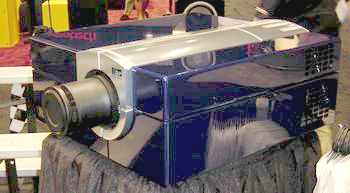
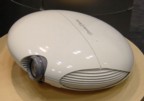
Whether you want a big beautiful box by Runco, or a cute elipsoid by
DreamVision, CEDIA had quite a selection of projectors.
The CEDIA video projector
news can easily be divided to two categories – Digital Light Projection, (DLP) and others. Texas Instruments (TI) was
the big dog at CES as the majority of new video projectors shown were based
on their DLP devices. The TI press release on CEDIA lists new products from
Digital Projection, Dream Vision, DWIN, InFocus, Loewe, Marantz, NEC, Optoma,
Runco, Vidikron, Samsung, Sharp, SIM2, Thompson, Yamaha, and Zenith. There
were other projector manufactures, such as Immersive missing from the press
release that also showed new DLP-based projectors.
The new non-DLP projectors include a seemingly “real” SXRD from
Sony
featuring 1080p resolution using a reflective LCD approach, and new D-ILA
offerings from JVC. Panasonic, Sony and others, were also out to prove that
traditional transmissive LCD technology was far from dead.
The news from TI included
three-chip 16x9 HD2-based projectors along with a new
HD2+ chip that provides improved contrast ratio and color accuracy.
Three-chip DLP Projectors
Several companies demonstrated HT projectors using
three 16x9, 1280x720, HD2
(Mustang) DLP chips. These three-chip DLP projectors don't use a color wheel
and project the red, green and blue colors simultaneously, thus eliminating
the “rainbows” some people are sensitive to with single-chip DLP projectors
as well as the need for extensive dithering. Previously three-chip DLP
projectors have only been available in 4x3 format, thus not ideal for HT
usage, and typically at a price well above $30k.
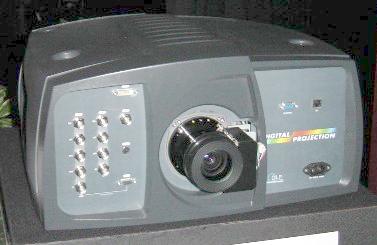
The
three-chip DLP Mercury was shown in TI's booth and in the very large DP
suite at the nearby Hyatt.
Perhaps the most impressive
three-chip DLP projector shown at CEDIA was the
Mercury from Digital Projection (DP). At the DP press conference, they
made it very clear that they were the ones who started digital cinema and in
1989 co-developed (with TI) DLP for use in digital projectors.
In the DP's suite they had 4 projectors as well as a most impressive
MediaWall. The four projectors included two large-venue three-chipper, the
largest projecting a stunning image onto a 22 foot wide screen. DP also
showed two products aimed at home theater market, the Mercury and the iVision.
As mentioned above, the Mercury is a three-chip DLP using HD2
technology. Critical specifications include 1750 ANSI lumens and a contrast
ratio of 2200:1! The Mercury offers a choice of lens from 0.8 to 7 in term
of throw ratios. Price? – Under $30K! Images on the Mercury had very smooth
character with natural color and motion, good brightness and more than
adequate contrast. This was a very easy projector to watch.
The availability of
three-chip 16x9 DLP projectors (no rainbows or dithering)
with good brightness and contrast, and at a price point below $30k is a very
good thing and will make many setting up a high-end HT very happy, although
perhaps quite a bit poorer. (Interestingly, TI suggests that the three-chippers
are for “Home Cinema” while the less expensive single-chippers are for “Home
Theater”. I am not too sure that this differentiation will stick, but who
knows?)
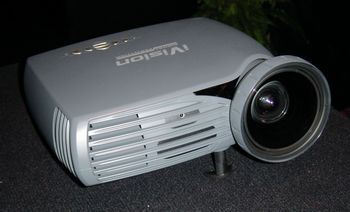
iVision with wide angle lens
The iVision is DP's first
single-chip DLP as all their previous projectors
have been three-chippers. The iVision is an HD2-based design with a contrast
ratio of 2300:1 and 1000 ANSI lumens. It can be purchase for about ~$12000
with either a long throw zoom lens, or the wide-angle very short throw lens
shown. While it is no doubt a fine projector, it sort of paled in comparison
to the 3 chippers next to it in the not completely darkened DP suite.
The 3 mega-pixel MediaWall that was demonstrated by DP was very cool and
used 3 iVision projectors (up to 7 projectors are supported!), a wide
rear-projection screen, and a Montage engine to give a very wide seamless
media wall or desktop. While it probably does not belong in a HT, it was
very impressive technology to see windows and images move seamlessly around
the screen, er, I mean media wall. Don't even ask about the price.
HD2+ DLP Chip for Enhanced Contrast Ratios
The other significant new development from TI is the HD2+ chip. The HD2+
chip has the “dimple fix” largely filling in the dimple at the micro-mirror
pivot-point. Previously, the dimple was responsible for some undesired light
scatter, and filling the dimple results in a little better light efficiency
and significantly improved contrast ratios – 15 to 40% depending on the
implementation. The HD2+ chip based projectors also add a seventh ”dark
green” segment to color wheel as well as two additional bits of information
(10) thus improving color accuracy and greatly reducing the need for
dithering at low IRE levels.
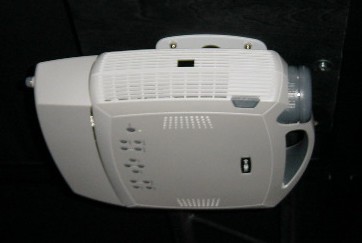
InFocus 7205 in TI booth
TI had an InFocus 7205 in their booth and even standing right at the
screen I could see no evidence of dithering in very dark areas of the
screen.
A number of companies demonstrated HD2+ designs. The first I saw in a proper
light-controlled demo environment was at Marantz, where they showed their
new S3. Although it was using a very high-gain screen, (the other ripped)
the black levels looked great. Marantz claims a contrast ratio for the S3 of
3800:1 and I could not dispute that based on what I saw. Marantz has made
other changes that improve color accuracy and overall color, blacks, etc,
looked great. I was a bit less impressed with their three-chip DLP demo, but it
was admittedly an early prototype and its brightness coupled with the very
high gain screen was likely not ideal.
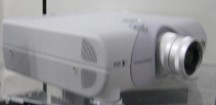
Marantz S3
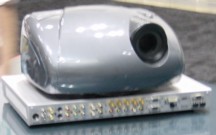
Sim2 HT300 Link uses an fiber optic cable to connect the image processor
to the projector.
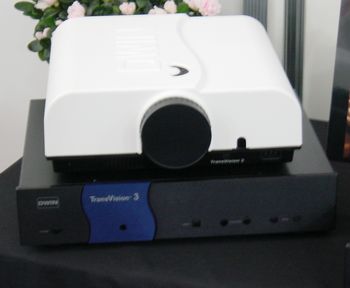
DWIN Transvision 3
Based on what I saw at Marantz, as well as SIM2, Infocus and Sharp
(4500:1 contrast ratio!), and others, I'd have to admit that the HD2+ chip
produces a noticeable improvement in contrast ratio and black level over HD2
based designs.
HD2-Based Projectors (Single-chip DLP)
So now that the HD2+ is out, does that mean that the HD2 based designs are
obsolete? Not really, as HD2+ based projectors aren't really shipping yet.
It does mean however, that HD2-based projectors likely will be “more
affordable”!
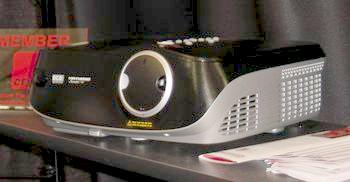
Imersive's
Virtuoso single-chip DLP projector
I must also say that some of the best images I saw came from HD2-based
projectors! For example, Immersive was demonstrating their HD2-based
Virtuoso using the DVD “Chicago”. The shadow details and details in the fog
and black behind the fog were as good as I have seen. Given its moderate
price and excellent overall performance, it deserves serious consideration.
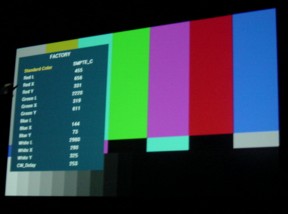
Showing off the image quality and calibration accuracy of the Samsung
SP-H700A
The Samsung SP-H700A also deserves special mention as it was designed and
developed in collaboration with Joe Kane. Joe was there to show off his
“baby”, and he was like any other proud father, but instead of baby pictures
the demo consisted of video clips and test images such as color bars, gray
steps and sharpness tests from his new Digital Video Essentials. It was
almost shocking to see video this clean and accurate. The video images also
looked great – no surprise given how well the test images looked. This was
all the more impressive in that all the “high definition” image were encoded
using Windows Media 9, a format that would allow full length High Definition
movies to be distributed using the capacity of current red laser DVDs.
Microsoft (and Secret's own Stacy Spears!) was obviously the third
collaborator in this fine effort.
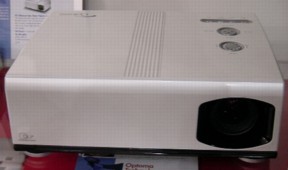
The Optoma H76
single-chip HD2-based DLP projector
The other product that many were waiting to see if it was “real”, was the
HD2-based H76 from Optoma. What has been causing the excitement around this
projector is its full set of features and an MSRP of $5995! It was there,
and it was being demoed continuously with Hi Def material. Since I had
previously seen the H76 at Optoma, I was not surprised by the excellent
quality of its image. At CEDIA, it looked like most all of the other HD2s –
which is to say, great. I certainly heard more than one H76 viewer remark,
“If I can get a HD2-based projector of this quality for less than $6000, why
should I pay significantly more for what seems to be marginal improvements”?
Good question.
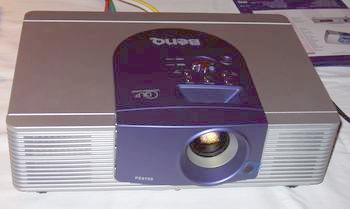
The BenQ
PE8700 single-chip HD2-based DLP
projector
The BenQ PE8700, which I recently reviewed, is available at a similar price.
BenQ was at CEDIA, but you had to know where to find them as they were in a
nearby hotel.
So, if you want a High Definition single-chip DLP-base projector, you now
have even more choices, ranging in price from below $6000 to well above
twice that for some of the HD2+ offerings. That is great. You just need to
decide what features and performance criteria are important to you and pick
your projector. (It's actually not as easy as that statement implies as I
can assure you from my own thinking about my next projector purchase.) In
any case, you will get performance in terms of contrast levels, black levels
and color accuracy unheard of several years ago in fixed panel (non-CRT)
based projectors.
Sony SXRD
Enough about DLP, lets move on to the SXRD (Silicon X-tal Reflective
Display), Sony's long expected three-chip 1080p (1920x1080) projector. I saw the SXRD at the San Francisco Home Entertainment show in its coffee table sized
box. At that time, I was impressed with its bright smooth image, but the
colors and gamma were a bit off, and the black level and shadow details were
not as good as Sony's claimed 3000:1 contrast ratio might imply.
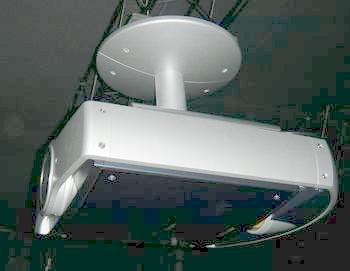
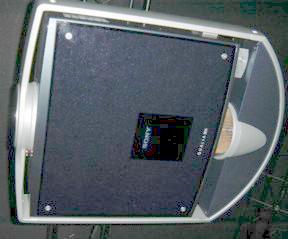
Two views
of the Sony SXRD-based Qualia 004
At CEDIA, the SXRD was in its final form and it looked very impressive, but
it was physically larger than I expected, not a coffee table, but
considerably bigger than my 11HT. The image it generated was brilliant, in
more ways than one. It was bright, even on a 160 inch 1.3 screen – an
obviously impressive light output. (The SXRD is based on a 900 watt Xenon
lamp. ) The image was also very smooth, without any obvious pixel structure –
having 1920x1080 pixels and a high fill factor certainly helps. The first
clip I saw was bits of a new movie starring Antonio Bandaras, Jonny Depp and
Salma Hyack called “Once Upon a Time in Mexico”. It looked very clean, and
the bright smooth image was very involving. The SXRD was being fed 1080i
with the deinterlacing performed by the projector. The black levels were not
as deep as that seen with best DLPs, but most who saw it thought the image
was very very good. Price? $25k to $30k.
The SXRD's image was
excellent, but was it worth say twice the price of an Marantz S3? Or 4 times the price of an H76 or BenQ 8700, etc? Or how about
comparing it to the Samsung or Virtuoso somewhere in between? But that is
the nature of our hobby or passion, or whatever. If you want to be on the
bleeding-edge, you pay lots for incremental improvements. If you wait a bit
or “bottom feed”, you will save some bucks and maybe upgrade more often. Your
choice.
I came to realize that the SXRD was probably too big and too bright (and too
expensive!) for my little 102” screen. Now maybe if they offered a lower
cost model with less brightness for less money. There is
speculation that this will happen, and the only real question is when.
D-ILA

High-end JVC
three-chip D-ILA projector
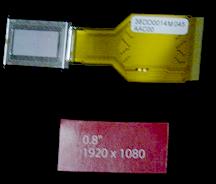
JVC's D-ILA
chip with 1080p resolution
The other major competing technology for the higher-end High Definition
projector market is, or course, JVC with their D-ILA based products. Like
the SXRD, D-ILA is a reflective LCD technology and has a very high fill
factor and therefore a very smooth image. JVC's theme this year was, "3 is
better than 1", as all their products feature 3 chip designs and don't use a
color wheel. D-ILA fans have long thought that they had the best of both
worlds with no Screen Door Effect (“SDE”), as with LCD projectors, and no
rainbows or dithering, as found with single-chip DLPs. Previously, however
D-ILAs were only available in a 4x3 format and tended to have limited
contrast ratios. Just prior to CEDIA however, JVD announced D-ILAs in a 16x9
format at a variety of resolutions including 720p and 1080p. Their new 16x9
product shown at CEDIA, the DLA-HX1U, uses a 1400x788 panel and claims a
contrast ratio of 600:1 with a selling price of $11,995.
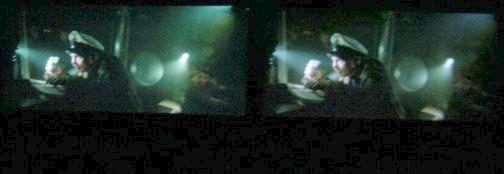
Comparison of images in JVC suite between D-ILA (HX1U) on left and single
clip DLP (unspecified) on right
JVC also had a very
interesting comparison test where they had their HX1U sitting next to a
“generic” single-chip DLP projector, projecting images on
two side-by-side screens. The two images were closely matched in terms of
color balance and appeared of equal brightness and black level, but the D-ILA
looked clearly better with much less video noise. JVC claimed this
comparison was fair as both their new HX1U and single-chip DLP's sold for
the same price, about $12k. The HX1s image was very smooth and free of
obvious video noise, but it was not clear to me if the single-chip DLP
chosen was truly representative of the current DLP technology available for
$12k, or even half that price.
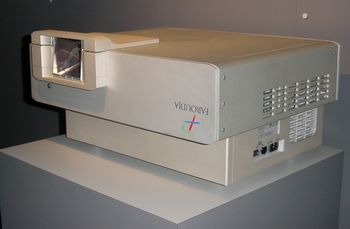
Faroudja was also showing D-ILA, in this case with a built-in anamorphic
lens.
Lower-Cost Projectors
OK, so what about lower cost projectors, or perhaps those with less then
High Definition resolution? What if you don't want to spend $6000 for a
projector, and what did CEDIA have to offer? First, CEDIA is a show for
professional installers who specialize in HT installations often costing
hundreds of thousands of dollars. Not too many of these installation are
therefore based on projectors costing less than $6k. Nevertheless, there
were several interesting new products that are worth mentioning.
Sony had two new products, the HS-20, a replacement for the incredibly
popular HS-10, and the HS-3. The HS-20 is a High Definition projector with 3
LCD panels, each with 1364x768 pixels. ANSI lumens are specified as 1400 and
contrast ratio of 1300. MSRP: $3500. The HS-3 has 3 858x484 pixel LCD
panels, 1200 ANSI lumens, a contrast ratio of 800:1 and an MSRP of $1500.
Sony had both of these projectors set up side by side with a black curtain
separating the projectors and screens, but arranged in a way that you could
easily view both images simultaneously. Both projectors looked good, but the
HS-20 looked better, as you might well expect. The major issue with
LCD-based projectors is the screen door effect and I must say that I find
both the HS-10 and HS-20 to have somewhat worse screen door than the Sony
11HT I use on a daily basis. I was aware of the Screen Door Effect on both
projectors at a viewing distance of approximately twice the screen width. Of
course, you can't see the actual grid, but, from my experience, the screen
door effect does make the image seem somewhat grainy, and perhaps less real,
compared to DLP images of similar resolutions. Nevertheless, given the HD
resolution, and the excellent brightness and contrast ratio for and LCD
projector, I have no doubt that the HS-20 will be even more popular than the
HS-10, and rightly so.
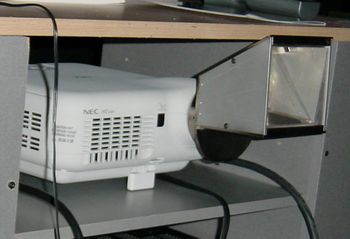
NEC HT1000 shown with optional anamorphic lens
The NEC HT1000 has also been a very popular projector offering contrast
ratios off up to 3000:1 using single-chip DLP, but with an XGA (1024x768)
format. Despite its single 4x3 DLP panel, the HT1000 was intelligently
configured to work well in the HT environment with a 16x9 screen, and
therefore has many enthusiastic followers. Many had hoped that NEC would
offer an HD2 based design at CEDIA, but it did not happened. Instead, NEC is
now offering, and were demonstrating, the HT1000 with an anamorphic lens
that allow use the full 1024x768 panel for 16x9 material. The image through
the anamorphic lens looked good, with good focus out to the edges, but with
some barrel distortion. The lens demonstrated however, was not necessarily
the final lens offering and current buyers are being given a certificate for
a lens in the future, or a $500 rebate.
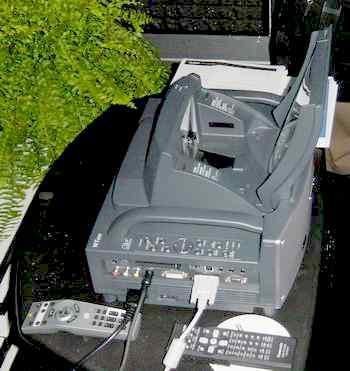
Is this a copy machine? No, it it is the NEC WT600 mirror-based
projector!
NEC also showed CEDIA's most unique projector, the WT600, a Mirrored
Reflection Projector featuring aspheric mirrors. Basically the WT100 can be
placed VERY close to the screen. For example, at a 26” distance to the wall
or screen, the WT600 can make a rectangular 100” diagonal image, well above
the projector. At 2.4” (yes two point four inches) from the screen the image
has a 40” inch diagonal. The WT1000 has clear value as a presentation
projector, but will also no doubt simplify HT setup if you don't want to run
cables to ceiling mounted projector. NEC certainly can claim the worlds
shortest throw ratio! You could potentially put this projector on your
equipment rack or on top of your center speaker and throw a big image on the
wall behind! The WT1000 is a truly unique product. Specifications are XGA
resolution, 1400 ANSI lumens, a 3000:1 contrast ratio, and an MSRP around
$6000.
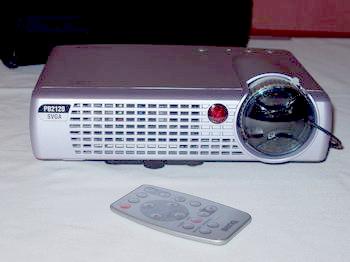
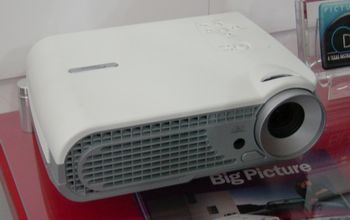
BenQ PB2120 and the Optoma H30
Both BenQ (PB2120) and Optoma (H30) introduced SVGA (800x600) single-chip
DLP-based projectors meant to serve both the business community and provide
a low cost solution to those building a Home Theater on a budget. MSRP on
both products is around $1500.
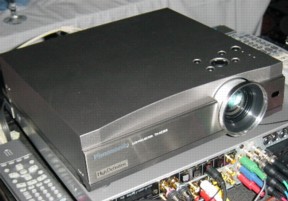
Panasonic
AE 500
At the Panasonic booth on the show floor, there was nothing to get excited
about in terms of video projectors, or even a hint of anything special, but
if you visited their suite in a nearby Hotel, you got not only a good lunch,
but also a chance to see the new AE500 LCD projector. (The 500 probably
won't be available in the States till after the first of the year). The
AE500 uses three 1280x720 LCD panels, but what makes it unique was seemingly the
complete absence of Screen Door Effect (SDE) in its projected image.
When we
recently reviewed the Panasonic 300U, we were very impressed with its smooth
image despite the fact that it was an LCD projector with limited resolution.
Well, with the AE500, Panasonic has taken their Smooth Screen Technology to
a new level. Even standing right at the screen, the pixel grid from the 500
was not really visible. There was a very fine pattern, but certainly not a
grid pattern and the overall effect on the smoothness of the image was
remarkable.
The 500, as demonstrated, was a prototype, and at times there
were other aspects of the image that didn't look quite right, but it was
very interesting to see that SDE, in my opinion currently the biggest
problem with LCD-based projectors, could be virtually eliminated! With the
potential for minimal SDE and with High Def resolution, contrast ratios well
above 1000:1 and with attractive pricing, LCD-based projectors are likely
far from dead in the HT marketplace.
Summary
So, at the end of CEDIA, the projector buyers' job didn't really get any
easier, but having lots of choices in never a bad thing for consumers. Whether you have
$1,500, or $15,000 or twice that, there is a projector out there waiting for
you!